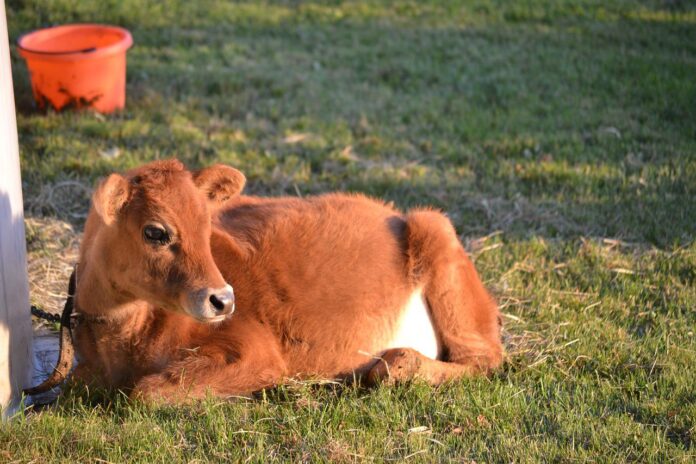When we introduce our bulls to the herd in June, we always make sure our milk cow, Pumpkin, has a few days head start.
Like all good jersey cows, Pumpkin produces far more milk and cream than one calf could ever dream of drinking — more milk and cream than one calf AND one family of four could dream of drinking, in fact, so we like her to calve early, in case there’s another baby who can help drink up the extra milk.
This year, we had just such a situation arise: a twin born out in the pasture whose mama decided she wasn’t interested in raising an extra baby. This poor little one was born too soon; however, and Pumpkin hadn’t had her own calf yet.
I took over bottle feeding “Little Jones” for the interim, thinking we probably wouldn’t even make it through half the bag of milk replacer. (Side note: “Why Little Jones?” I asked my daughter, the main animal namer. “Because it’s UNIQUE!” she replied with flick of her wrist.”)
A few days turned into a week, and Pumpkin still wasn’t “bagging up.” For the uninitiated, when checking cows or ewes, one of the signs that someone is going to have their baby soon is the size of her “bag” aka her udder.
“Bagging up,” or the udder expanding as it fills with milk, is a sure sign that labor is imminent. As you might expect, this is even more obvious on a milk cow.
By the time they give birth, I often wonder how they are able to walk, their udders look so uncomfortably full!
Five more days passed, then last Thursday, I noticed Pumpkin acting a little funny. She had a far away look in her eye, as though concentrating on something just out of sight, and she was standing off from the rest of her friends.
“Hmmm …” I thought, but when I walked around to check, her bag still looked relatively small. “Not yet,” I said aloud and headed back to the house.
When I returned a few hours later, I spotted her laying flat out in the dirt of the corral. “Oh no!” I shouted and broke into a run, kicking myself because the faraway look had clearly been a sign of illness, not labor.
But, as I came up beside her, I realized there was a sticky, wet blob lying there too. She’d apparently just given birth to a little red-and-white calf, and both were resting peacefully.
Happiest time
All’s well that ends well, which is to say, we have now entered the happiest time of year for a hand-milker. Dawn is heralded every day by a chorus of birds; the dew on the ground may have the sheen of frost, but it doesn’t last.
Evening is much the same. The air is fresh, scented with the misted green of the first grass.
Most importantly, there’s not a fly in sight. Morning and evening milkings, therefore, are a treat not a chore.
Oh, and those cups of good, sweet milk after a whole winter without! I could write an entire column about the pleasure of those first sips — not to mention the yogurt, butter and, my favorite, fresh cream in your coffee. The abundance is a daily blessing. Little Jones agrees.
Reconstituted milk replacer is really not a very nice replacement for the thick, rich milk that flows out of a real-life jersey mom. Little Jones’s expanding flanks prove this point, as does the sudden cessation of the mournful “mooooooooos” emanating from the orphan pen.
For everything, there is a season. In a few months, I will be singing an entirely different tune, as I milk in the dust and heat, getting swatted by Pumpkin’s strong, wiry tail while she tries to shoo away biting flies. And that is also as it should be.
Spring milking is a dream within a dream, summer milking a bit of a burden. By autumn we are sick of fresh milk and thankful to let Pumpkin dry up, thus allowing the long cold of winter to transform the burden back into a blessing once again.













